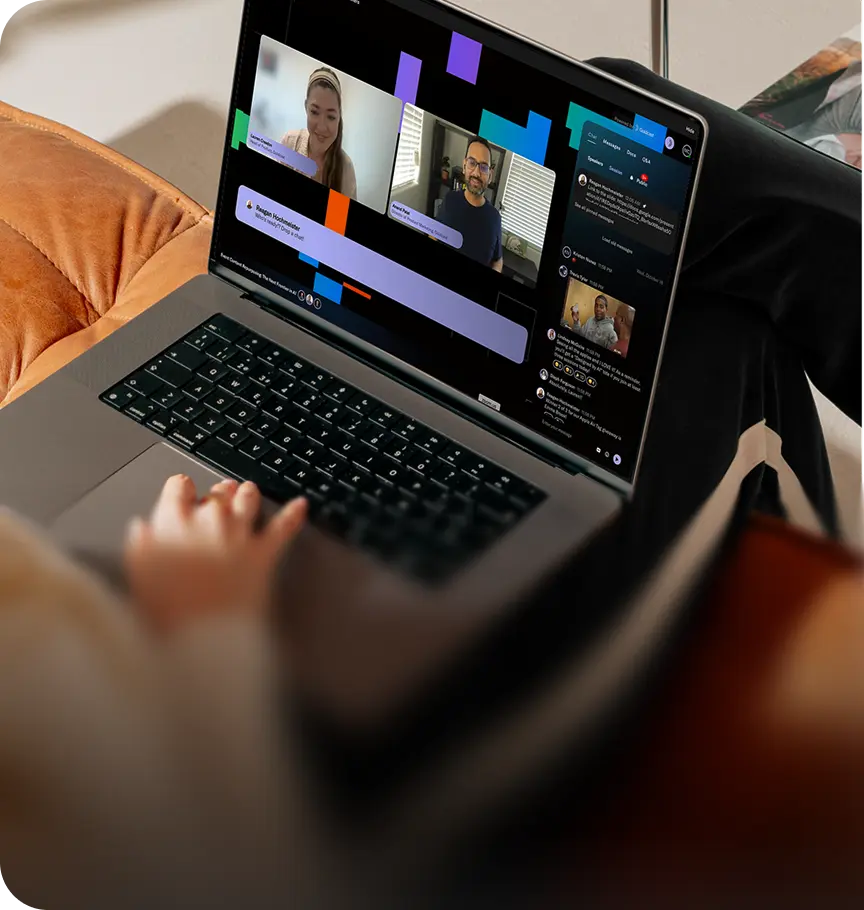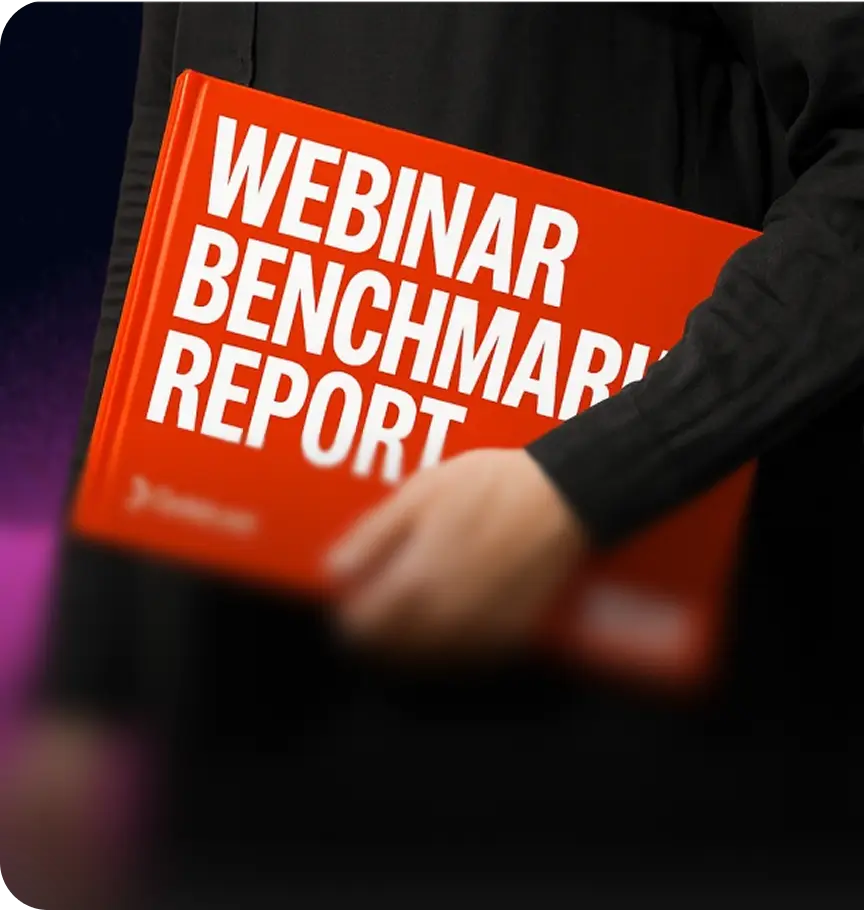Creating Content That Sparks Conversation

Table of Contents
Maximize Your Marketing ROI
Join 10,000 other marketers already getting the best tips on running engaging events that boost pipeline and create raving fans.
Remember when creating "good content" was enough to stand out? Prospects are drowning in a sea of whitepapers, blogs, and social posts — and that's just from your competitors. Add in all the AI-generated noise, and it's getting tougher than ever to catch (and keep) attention.
But while everyone else is cranking out generic content, you can be the brand that creates genuine connections.
The content saturation challenge
Think about what your LinkedIn feed looked like even a year ago versus now. Perfectly polished corporate videos are giving way to something much more raw and real.
“The majority of marketers are now using video for lead generation on LinkedIn,”says Alex Rynne, Senior Content Marketing Manager, Marketing Solutions at LinkedIn. “Some folks think video is just a top-of-funnel activity, but it's very much not.”
And the numbers back this up — video uploads shot up 34% compared to last year, according to LinkedIn’s latest B2B Marketing Benchmark Report.
"The days of perfect production values mattering more than genuine connection are behind us. We're seeing a massive shift from highly polished, corporate content to more authentic, human-centered storytelling."
This evolution reflects a broader trend in B2B marketing: the move from broadcasting to conversation, from polish to authenticity, and from quantity to quality. 🌟
The video-first content revolution
In a world where everyone's shouting, the voices that resonate are the ones that feel real.
Just check the data:
- Video generates 5x more clicks than static posts
- Video drives 3x the engagement of text-based posts
- 85% of B2B marketers use video for lead generation on LinkedIn
- 60% of LinkedIn engagement happens on mobile
“I've done a lot of videos just for fun to educate people that follow me. Our team ended up putting some thought leader ads behind them. They were very top-of-funnel and didn't even mention video ads or CTV ads, but they've actually been some of our top converters,” says Alex.
But it's not just about results — it's about connection.
"People buy from people, not from companies. Video helps give your organization a face and personality."
Image - Video performance comparison chart (video vs. static vs. text posts)
A strategic content framework for making video work
So how do you actually put this video-first approach into practice? Alex breaks it down into three clear steps: Start with objective, then content creation, then KPIs.
Choosing the right objective
Before you hit record, get clear on what you want your video to achieve. As Alex explains, different video types serve different purposes in your marketing funnel:
- Product demos: Focus on conversion metrics like MQLs, clicks into campaign manager, or direct sales outreach
- Product launch announcements: Prioritize awareness and reach over immediate lead generation
- Thought leadership: Build brand authority and engagement
"If it's more of an awareness play — like 'Hey, we just launched event ads' — then MQLs aren't necessarily the goal," Alex notes. Trying to force every video to drive leads can backfire.
Instead, align your objectives with where the content sits in your marketing funnel:
Top of funnel:
- Brand awareness
- Reach new audiences
- Social engagement
Middle of funnel:
- Product education
- Feature demonstrations
- Use case exploration
Bottom of funnel:
- Sales enablement
- Customer conversion
Let your overarching objective guide everything from format to distribution to metrics.
"There's a place for every type of video. Even some TV ads look like they were shot on an iPhone now — it doesn't have to be a big $10,000 production," says Alex.
Creating videos that stick
Forget everything you learned about "professional" content creation. The new rules of engagement are simple:
“If I'm not having fun creating this content, then the folks consuming it aren’t either.”
Alex’s best advice? “Lean into your weirdness. It doesn’t have to be perfect.”
The three-second rule
"You have a really short time frame," Alex emphasizes. The first 3 seconds of your video need to grab attention, especially since most people are viewing on mobile:
- Make your value clear immediately
- Address your audience directly ("Hey, demand gen marketers!")
- Include captions (80% watch without sound)
- Get straight to the point
Image - Mobile-first content creation checklist
Essential tools for quality video
You don't need expensive equipment to create engaging content. Here's what Alex recommends:
- Content planning: Jasper AI for scripting and ideation
- Video creation: Canva for simple editing
- Basic equipment:
- Lume Cube for reliable lighting
- Lapel mic for clear audio
Testing & optimization
- Give organic content 1-2 weeks to see how it performs
- Put paid promotion behind top performers
- Look at metrics monthly for paid campaigns
- Test different formats and approaches
Common mistakes to avoid (that you might be making right now)
"For a long time in marketing, we've bought into this unreasonable expectation of corporate professionalism that just isn't how people communicate anymore,” says Alex.
Ready to ditch the corporate robot voice? Here are the mistakes you'll want to avoid:
- Over-polishing videos: “Talk to your audience the way you'd talk to colleagues in the office. Be yourself," Alex advises. Keep it natural and authentic.
- Skipping captions: With 80% of social videos watched on mute, captions are essential. Double-check auto-generated text for accuracy.
- Making videos too long: Keep content concise — attention spans are limited.
- Focusing on wrong metrics: Don't dismiss "vanity metrics" — video serves the full funnel, not just MQLs.
- Talking only about yourself: Focus on audience value over company promotion. Drop the corporate speak and communicate like a real person.
Last but not least, never forget the golden rule of video content:
"Focus on the customer-centricity of it all — what's the value for them? Let your personality shine through and inject humor if that's your vibe, but at the end of the day, it's about what's in it for your audience."
AI-powered content scaling
According to our research at Goldcast, a whopping 91% of marketers are already using AI tools, and most of them are focusing on content creation. It's not hard to see why.
As Alex puts it:
“What used to take us weeks can now happen in days. But it's not just about speed — AI is helping us be more creative and experimental with our content."
77% of marketers say AI is delivering the most value in content creation, and 84% believe it'll be make-or-break for hitting their marketing goals in the next few years.
But there's a catch. With only 1 in 4 B2B marketers feeling like they have an “extremely good understanding” of how to use AI in their everyday activities, we’re still a long way from finding our best use cases.
A practical playbook for content distribution & repurposing
Here are some of the ways Alex and her team use AI to scale their content efforts across channels (without zapping all creativity from the process):
- Jasper for writing and editing support
- AI tools for audience segmentation
- Copilot for meeting notes and action items
- LinkedIn Accelerate for campaign optimization
Multi-format strategy
When it comes to posting frequency, Alex emphasizes consistency over volume: "Consistency is more important than the amount of videos that you're putting out, because then people can better understand what to expect from you."
The good news is, one piece of content can (and should) fuel multiple formats:
- Transform blog posts into carousel posts
- Extract key webinar takeaways from for social snippets
- Convert long-form videos into short-form clips
- Create audiograms from video content
- Pull quotes for social media graphics
- Develop infographics from data points
Platform-specific optimization
Each social platform has its own personality, and your content needs to match:
- Professional tone, but increasingly conversational
- 1-2 minute video sweet spot
- Business hours posting for optimal reach
- Focus on thought leadership and industry insights
- Visual-first approach
- Carousel posts for educational content
- Stories for behind-the-scenes glimpses
- Reels for quick tips and trends
Building content series
Ready to transform your content from random acts of marketing into must-watch moments? Try building a content series — think:
- Weekly themed content drops
- Monthly expert interview series
- Regular "quick tip" segments
- Industry trend analysis series
- Behind-the-scenes features
For optimal distribution:
- Post 1-2 videos per week consistently
- Space out content rather than posting everything at once
- Consider creating series content for regular engagement
- Front-load content creation to maintain consistency
"Think about content like a TV show," Alex suggests. "Your audience should know when to expect new episodes and what kind of value they'll get from each one."
Her not-so-top-secret pro tip? "I batch record multiple videos in one session — usually around six or seven. I just change my top between takes so it looks like different days. That way, I can drop one every week consistently without losing momentum or credibility with the audience."
Once you’ve got your video library up-and-running, the content opportunities are endless. Insights no longer live and die in a single video. Instead, you're using video content as a marketing multiplier — strategically amplifying your message across platforms while maintaining an authentic voice.
Measuring success beyond vanity metrics
Launching a video strategy sounds great and everything, but in the age of zero-click content, how do you know your efforts are actually paying off?
The multi-level measurement framework
When measuring video content success, Alex recommends looking at 3 key levels:
Top-of-funnel engagement
- Views and watch time
- Social shares and saves
- Comment quality and volume
- Profile visits after viewing
Mid-funnel impact
- Content downloads
- Email signups
- Event registrations
- Follow-up content consumption
Bottom-funnel conversion
- Sales conversations initiated
- Demo requests
- Direct revenue attribution
When it comes to measuring video success, stick to a practical approach:
"Video content can serve multiple purposes throughout the funnel, and each metric tells part of the story," explains Alex. "Don't dismiss metrics just because some people call them vanity metrics."
Using organic as your testing ground
Rather than jumping straight into paid campaigns, Alex advocates for an organic-first approach to content testing.
Initial testing period
- Post content organically first
- Allow 1-2 weeks for natural performance
- Track engagement patterns and audience feedback
Performance analysis
- Identify which topics resonate most
- Note optimal posting times
- Analyze engagement quality (comments vs. likes)
Paid amplification strategy
- Select top-performing content for paid promotion
- Use organic insights to refine targeting
- Scale what works through paid channels
"Think of organic as your focus group," Alex advises. "It's a low-risk way to test what resonates before putting budget behind it."
Creating a balanced scorecard
Ready to level up your measurement game? Create a comprehensive scorecard that looks at:
- Quantitative metrics (views, shares, conversions)
- Qualitative feedback (comment sentiment, sales team feedback)
- Business impact indicators (pipeline influence, revenue attribution)
- Long-term brand building metrics (follower growth, share of voice)
The goal isn't to chase numbers — it’s to understand how your video content is moving the needle on your revenue goals and objectives.
Key takeaways & next steps
- The future of B2B content is video, but authenticity matters more than polish — buyers want real conversations, not corporate broadcasts.
- Tip: Record 5-6 authentic videos in one session to maintain consistent posting without losing your natural voice.
- Success in video requires both systematic measurement and strategic distribution across platforms.
- Tip: Create a simple testing framework: post organically for 2 weeks, then put paid spend behind your top performers.
- Mobile optimization isn't optional — with the majority of LinkedIn engagement happening on phones, your content needs to work on small screens.
- Tip: Always add captions, keep videos under 2 minutes, and lead with your strongest point in the first 3 seconds.
Don't let perfection be the enemy of progress. Start creating, be yourself, and focus on delivering value to your audience. The polish will come with practice, but the authenticity needs to be there from day one.
Transform Your Video Marketing with AI
Stay In Touch
Platform
Resources
© 2025 Copyright Goldcast, Inc. All rights reserved.





 Upcoming Events
Upcoming Events Event Series
Event Series On-Demand Events
On-Demand Events

